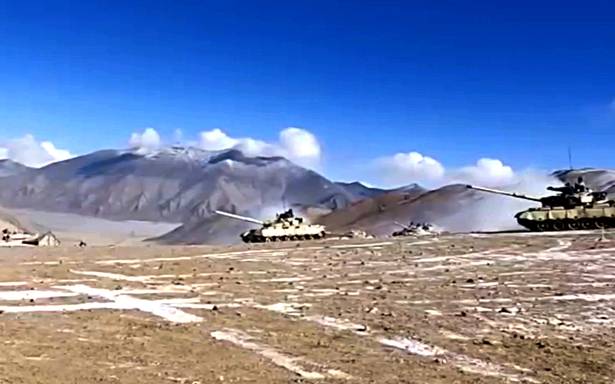Implementation of agreement started on Wednesday in North and South Banks.
India and China have reached an agreement on disengagement in the Pangong lake area to cease their forward deployments in a phased, coordinated and verified manner and it would substantially restore the situation to that existed prior to the commencement of the stand-off last year, Defence Minister Rajnath Singh said on Thursday.
Also read: India, China agree to return to pre-April 2020 positions in eastern Ladakh
“The Chinese side will keep its troop presence in the North Bank area to east of Finger 8. Reciprocally, the Indian troops will be based at their permanent base at Dhan Singh Thapa Post near Finger 3. A similar action would be taken in the South Bank area by both sides,” Mr. Singh said in the Rajya Sabha.
Union Defence MInister Rajnath Singh at Rajya Sabha, during the ongoing Budget Session of Parliament, in New Delhi on February 11, 2021. Videograb: RSTV/PTI
“These are mutual and reciprocal steps and any structures that had been built by both sides since April 2020 in both North and South Bank areas will be removed and the landforms restored,” he said.
Temporary moratorium
Further, both sides had agreed on a temporary moratorium on military activities in the North Bank, including patrolling in the traditional areas.
“Patrolling will be resumed only when both sides reach an agreement in diplomatic and military talks that would be held subsequently,” he stated.
The implementation of this agreement started on Wednesday in the North and South Banks, and officials said withdrawal of tanks had been completed in some areas of South Bank.
Also read: Both sides disengaging from Pangong lake area, says China
“I want to assure this House that in these talks we have not conceded anything,” Mr. Singh said. There were still some outstanding issues with regard to deployment and patrolling at some other points along the Line of Actual Control (LAC) in eastern Ladakh. These would be the focus of further discussions with the Chinese side, he said.
Both sides have agreed that they should achieve complete disengagement at the earliest and abide fully by the bilateral agreements and protocols. By now, the Chinese side was also “fully aware of our resolve”. “It is, therefore, our expectation that the Chinese side will work with us in full sincerity to resolve these remaining issues,” he asserted.
India had consistently maintained that while bilateral relations could develop in parallel with discussions on resolving the boundary question, any serious disturbance in peace and tranquillity along the LAC in the border areas was bound to have adverse implications for the direction of our bilateral ties. “The actions by the Chinese side since last year have seriously disturbed peace and tranquillity. Consequently they have also had an impact on the overall relationship,” he observed.
Naidu’s denial
After Mr, Singh’s statement, Rajya Sabha Chairman M Venkaiah Naidu denied opportunity to members to seek clarifications on the statement. He said it was a a matter of national unity and security. “Discussions are to go on for the next 48 hours and we don’t want to create a controversy; it is not good,” he said, adding that he would consider the demand for an in camera meeting with the Minister.
Step by step agreement
On Wednesday, local commanders on the ground at Pangong Tso (lake) met face to face before the pullback began.
Tanks and mechanised elements have started moving back from South Bank and distances, including the latitudes and longitudes, up to which they have to move back, had been agreed upon in the agreement, a defence official said. Both sides have worked out a detailed step by step plan for pullback of troops and equipment, the official stated.
Joint verification would be done together at each step and the local commanders were in regular communication, the official added.
Pre-emptive move
In a pre-emptive move on August 29 and 30, the Army occupied some unoccupied heights in the Chushul sector from Thakung to Rechin La within the Indian perception of the LAC, foiling the Chinese People’s Liberation Army (PLA) attempts to dominate the heights.
As part of the agreement, the Indian Army will vacate these peaks and pull back troops and equipment, while China would remove structures between Finger 4 to Finger 8 on North Bank and withdraw troops.
The Army has deployed around 50,000 troops in addition to tanks and other equipment along the disputed boundary in eastern Ladakh to match the Chinese deployments since the beginning of the stand-off in early May after ingress and build-up by PLA troops at several locations on the Indian side of the LAC.
As part of the first phase of disengagement in June last, both sides had pulled back troops by equal distance from Patrolling Points (PP) 14 in Galwan valley and PP15 in Gogra-Hot Springs. It was during the disengagement at Galwan that violent clashes occurred, resulting in the death of 20 Indian personnel and an unknown number of Chinese casualties.











